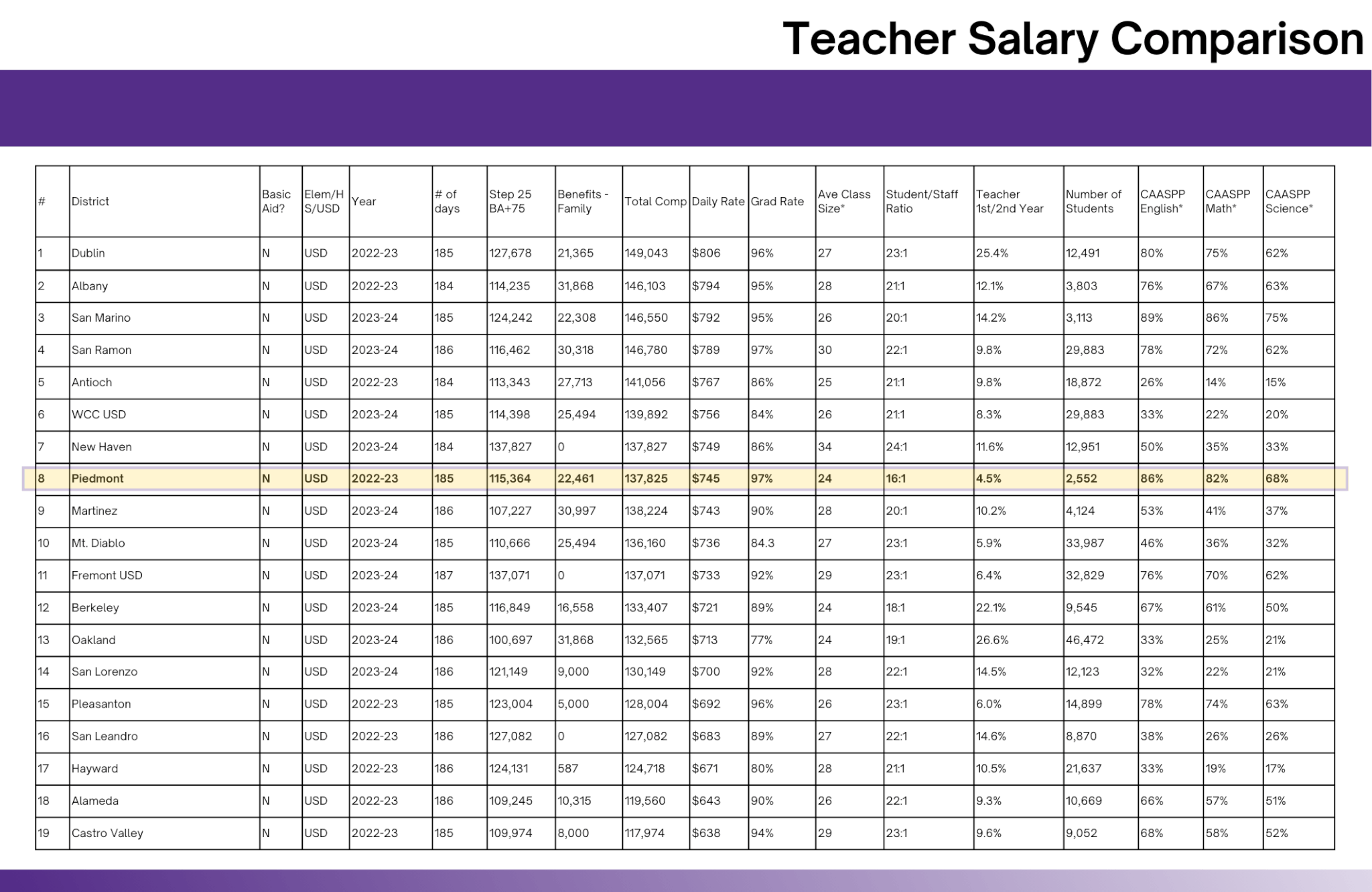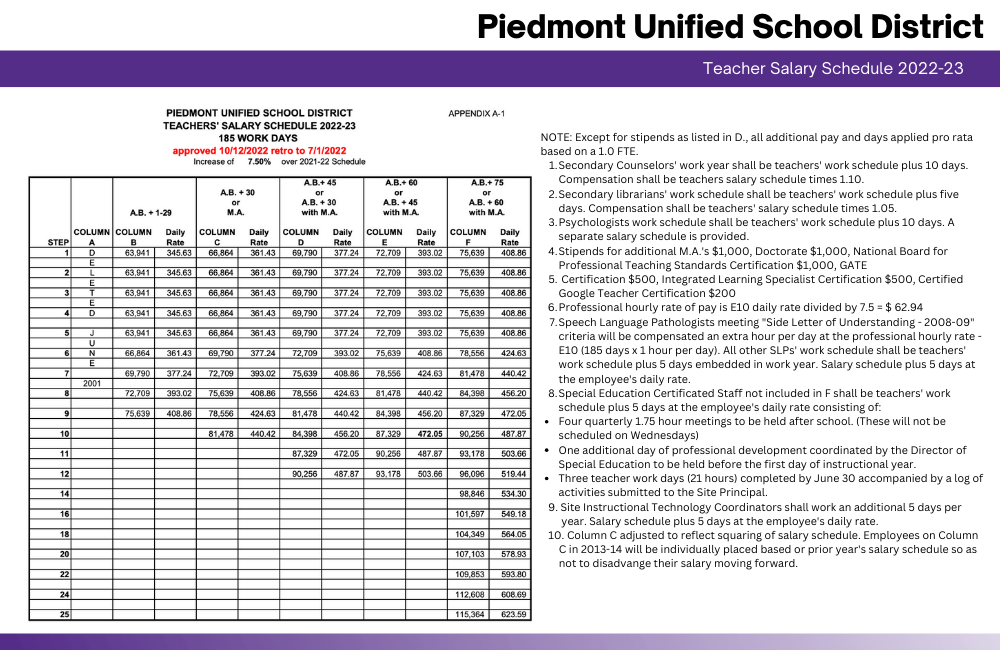Everyone deserves a living wage. Piedmont Education Foundation supports the Association of Piedmont Teachers, Piedmont’s California School Employees Association, and Piedmont Unified School District in their efforts to provide all employees with a meaningful salary increase.
While the need is obvious, the solution is elusive.
PEF respects the need for private negotiations between the District and Unions. But, we also understand that our community has questions about budgeting and how compensation is calculated. We hope the information below answers some of those questions. Information on salaries, benefits and budgeting is presented at PUSD’s monthly Budget Advisory Committee meetings and shared at school board meetings.
How do teacher salaries at PUSD compare to other districts?
At PUSD the top APT (Association of Piedmont Teachers) salary is $115,364. Teachers also receive health benefits that average (for a family) at $22,461 per year, and PUSD pays into teacher pension funds at a rate of 19.10% of teacher salary. Teachers receive pensions from CALSTRS on retirement — about 54% of their ending salary after 25 years of service — but are not eligible for social security payouts. Salaries of a 1.0 FTE (full time equivalent) teacher are based on 185 days worked each year. By comparison, PUSD principals work 220 days per year and directors work 225.
The average teacher salary at PUSD in 2023-24 is about $96,500, a daily rate of $522. The most recent data from CalEdFacts, a service of the California Department of Education, is for 2021-22. At that time, the average teacher salary in California was $88,508.
Comparisons can be challenging. There are significant differences between types of districts even within the same county. In most counties, teachers at elementary school only districts make less than teachers at unified districts, while those at high school only districts make more. There is also wide variation in the salary schedule within the same school district based on years of experience, years of service, degrees, and certifications. Earlier this year, the PUSD Standards and Criteria committee met for the first time in over 10 years and developed a method to determine comparable school districts and salaries. Below is the information provided by this committee. PEF has added additional contextual data to this grid, starting with the information on graduation rates.

The districts listed are from the PUSD Standards and Criteria Committee. Composed of members of APT, PUSD administrators and a school board member, the S&C Committee created a document comparing teacher salaries and benefits at 19 comparable school districts. They created a formula to come up with comparables for school districts with large salary scales, benefit variations, and working days. The comparison is based on a “daily rate”. The calculation starts with “Step 25 BA+75” from the annual salary schedule (top of the range – teachers with 25+ years of experience and a bachelor’s degree with an additional 75 teaching credential points), adds the amount each district spends for family benefits and gets total compensation. That number is divided by the number of working days to get a daily average rate. The district salaries are ranked accordingly.
Teacher Salaries 101
Each year, the Association of Piedmont Teachers (APT), PUSD’s teachers union, enters into negotiations with the school district. Negotiated points include working hours, class sizes, benefits, retirement incentives, safety conditions, evaluations, and, of course, salaries and raises. The 2020-2023 contract is available on the PUSD website, as is the current salary schedule. In 2022-23, PUSD teachers received a 7.5% salary increase.
PUSD uses a “step and column” system to determine regular teacher salary increases outside of the negotiation process. Columns are based on level of education and education credits. A teacher with a master’s degree in their first five years of teaching would earn $66,864, and once they earn an additional 15 education credits, their base salary increases to $69,790. In addition, teachers are eligible to receive salary increases by going up a step. Step salary increases begin at the 6th year of experience and increase each year between 3.1% and 3.9% until year 12 when salary increases come every two years, at between 2.5% and 2.9% until year 24. The final step to 25 includes a 2.4% increase. The average dollar increase is $2.838 per step.
Cost of salaries to PUSD
When PUSD is considering pay increases, they must take into account the total cost to the district, which includes health benefits, varying by the plan each employee selects, as well as salary-driven benefits. Salary-driven benefits for certificated staff include STRS retirement contributions at 19%, and unemployment, medicare and worker’s compensation totalling 3.33%. A teacher at the bottom-right of the salary schedule receives a base salary of $115,364. If this teacher opts for the family benefits plan, PUSD’s total expense is $168,602. PUSD caps health benefits contributions for a family plan at $22,461. With the increase to Kaiser rates in 2024, teachers with a family plan will need to contribute an additional $9,500, more than twice what they are paying in 2023, just to maintain their current health plan. The benefits cap is similar for classified and administrative staff, and PUSD expenses include an additional 36.21% for classified staff salary-driven benefits.
What about staff salaries?
We use the term “staff” in this context for classified staff, those eligible for membership in the California School Employees Association (CSEA – Piedmont Chapter 60). This includes a wide range of positions, covering student support, maintenance, and certain administrative positions. Paraeducators, custodians, health clerks, accountants, library aides, school secretaries, food service workers, and more fall under the “staff” umbrella. The negotiation process is similar to the one used by teachers. You can see the current CSEA contract here and the current CSEA Employee salary schedule here. Each position has a separate salary range, and all staff are eligible for incremental longevity increases. CSEA positions can be 10, 11, or 12 months and salaries range widely based on position. CSEA employees are also eligible for health benefits. PUSD also pays into CALPERS for staff retirement benefits at a current rate of 26.68% of each employees’s base salary.
Where do management employees fit in?
The Association of Piedmont School Administrators (APSA) includes certificated, confidential, and classified management personnel. This includes principals, assistant principals, and director level administrators, but does not include the positions of Superintendent, Assistant Superintendent, and Chief Business Officer, which are contract positions. The current APSA MOU is available here.
How much does PUSD spend on administration?
In November, the PUSD Budget Advisory Committee (BAC) did a deep dive into budgeted district expenditures for 2023-24. The presentation included a breakdown showing that 54% of the budget is for certificated salaries and benefits, excluding administration, 21% is used for Classified Salaries & Benefits, excluding administration, and 9% for administrator salaries and benefits.
Where did the funds from Measure H go?
The passage of Measure H in 2019 provided the district with an additional $2.5 million per year. PUSD was able to increase APT salaries by 2% in 2019-20, 6% in 2020-21, 2.5% in 2021-22 and 7.5% and a one-time $1,500 payout in 2022-23. CSEA negotiated a bit differently, with each employee receiving an ongoing $1,116 increase regardless of current salary in 2019-20, 6% in 2020-21, 3% plus a health benefits cap increase in 2021-22 and 7.5% plus $300 and a one-time $4,250 payout in 2022-23. While these increases have not kept up with the cost of living, the ongoing salary increases have accounted for all the funds from Measure H.
What is COLA and how does it relate to teacher salaries?
Cost of Living Adjustment (COLA) in this context is an increase in LCFF funding intended to allow school districts to retain their purchasing power in the face of rising costs for goods and services. This year’s state COLA adjustment is 8.22%.
While the COLA adjustment to LCFF increases the funds that the state provides to each district, this does not translate directly to teacher salaries for a few reasons. For one, the LCFF is also based on Average Daily Attendance (ADA) and ours has decreased significantly, though remains consistent with the decrease in other Bay Area Schools. For another, LCFF funding accounts for only 52% of PUSD revenue. A full 27% comes from Piedmont’s parcel taxes, which increase by a maximum of 2% each year (Measure G only). 11% comes from other state and federal funding, and the remaining 10% from PEF and local support. Declining enrollment means that the base LCFF funds for this year are less than that of last year, making the difference between LCFF funding in 2023-24, and 2022-23 is only $1,033,924 — even with the 8.22% increase. That difference accounts for only 2.2% of PUSD’s revenue budget.
Why does PUSD spend so much on Benefits?
Benefits include health care, capped at $22,461 per employee, as well as annually increasing pension payments. In 2023-24, PUSD is contributing an amount equal to 19.1% of teacher earnings to CALSTRS and 26.68% of classified staff earnings. In comparison, the contribution rates in 2013-14 were 8.3% and 11.4% respectively. The increasing employer contributions toward these pensions is a result of California’s pension plans being significantly underfunded due to major portfolio hits in 2000 and 2008. In order to recover funding, the state has required school districts to pay a dramatically increasing percentage of teacher and staff salaries to make up the difference. This increase comes at a significant cost to PUSD and other school districts, but does not translate to an increase in pensions payouts to teachers and staff after their retirement. When a teacher retires, they are not eligible for social security, but they are eligible to receive a monthly income up to 84% of their highest salary in retirement.
How do we give our teachers and staff a significant, ongoing salary increase?
PUSD strives for a zero-sum, balanced budget. They commit to spending all funds received through government and local sources on immediate needs, save for a state-mandated 3% reserve, and so do not have any additional pockets of money. Over 80% of the district’s expense budget is dedicated to salary and benefits. 42% on certificated salaries, 13% on classified salaries, and 27% on benefits. The remaining 18% is spent on books, supplies, services, and operating expenditures. PUSD has spent years trimming expenses as far away from the classroom — and teachers — as possible. CSEA staff share that they have taken on significantly more responsibilities as non-teaching positions have shrunk. While teaching staff have been rightsized to account for the decreasing student population, there have been little changes to the student/teacher ratio. PUSD would need to decrease the number of teachers in order to provide the remaining ones with significantly higher, ongoing wages.
The Piedmont community has put too much into its schools to allow this to happen. Our small classroom sizes and the breadth of classes we offer set PUSD apart. The APT contract limits the number of students to an average of 25 per class, and the middle and high schools both offer 7 periods while many nearby school districts offer 6. Right now, the best we can do is continue to advocate for California to provide a meaningful, ongoing increase in funding to its schools.
Why can’t PEF pay for teacher raises?
PEF’s annual grant focuses on supporting teachers, dedicating over 70% funds raised to teacher salaries. Additionally, the grant helps pay for student support staff, including counselors, therapists, library and classroom aides, and paraprofessionals. If PEF were able to double our annual fundraising and maintain that rate over time, we would be able to support ongoing salary increases.
Hopefully, this answers some questions about teacher compensation. If you have additional questions, please contact the PEF office at info@piedmontedfoundation.org or 510-653-1816.




